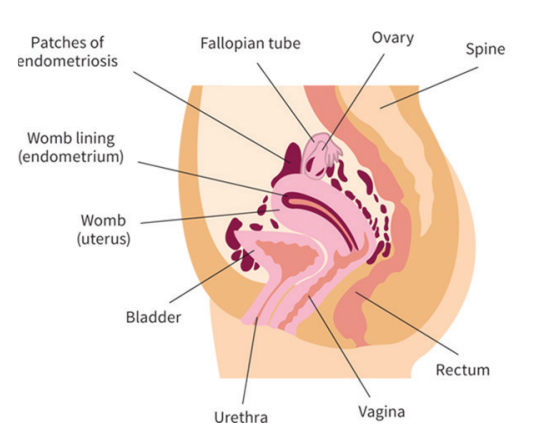Endometriosis: A GP guide to endometriosis management
A Fact Sheet by A/Prof Donald Angstetra
- Endometriosis can affect up to 10% of women.
- Diagnosis is typically delayed by 7-9 years since the onset of symptoms
- Consider endometriosis diagnosis in any woman with debilitating menstrual, sexual or ovulation pain, or unexplained infertility
- Laparoscopy is the gold standard for diagnosis and treatment to improve pain and fertility outcomes
What is endometriosis?
A condition where tissue-like endometrium (inner lining of the womb) is found elsewhere, usually in the pelvis. It affects 1 in 10 women. It can have a significant impact on physical health, emotional wellbeing and daily routine.
Where does endometriosis occur? 
- Ovaries, known as endometrioma (chocolate cyst)
- Peritoneum (lining of the pelvis)
- Fallopian tubes
- Area between vagina and rectum
- Bowel and/or bladder (uncommon)
- Other – lung, diaphragm (rare)
What are symptoms of endometriosis?
Symptoms can vary or there may be no symptoms at all. The main symptoms are:
- Pain – Pelvic pain, painful periods and painful sex are common
- Bladder and bowel issues – such as constipation, bloating or diarrhoea and increasing pain to urinate
- Infertility – 30% of sufferers have trouble getting pregnant
How does endometriosis cause problems?
Endometriosis growth depends on oestrogen. It can grow and bleed like the uterine lining does during the menstrual cycle. Surrounding tissue can become inflamed, irritated and scarred which can cause pain. The scar tissue (adhesion) can cause pelvic organs to stick together.
How is endometriosis diagnosed?
Ultrasound can help to diagnose an endometriotic cyst in the ovaries or may suggest endometriosis between the vagina and rectum. Deep infiltrative endometriosis ultrasound, performed by experienced practitioners, can facilitate diagnosis. Laparoscopy is the gold standard to get a definite diagnosis. This is a surgical procedure whereby a small telescope is inserted through umbilicus (belly button) to look at the pelvic organs.
How is endometriosis treated?
Treatment for endometriosis depends on your symptoms, the extent of the disease and your desire to have children.
What medications are used to treat endometriosis?
- Simple pain relievers: Paracetamol and non-steroidal (Naprosyn or Ponstan) can help relieve pain
- Oral contraceptive pill: Oral contraceptive can stop ovulation to reduce oestrogen levels. This can help settle the endometriosis but will not make endometriosis disappear.
- Progesterone hormone: Dienogest (VisanneTM) is a progesterone-only hormone that has been shown to reduce the growth of endometriosis.
- GnRH-agonists: Zoladex can switch off the release of reproductive hormones. The side effect is menopausal symptoms in which women may find unpleasant.
- Mirena: Mirena is an intrauterine system which releases progesteronelike hormone to reduce the pain and make periods lighter.
Summary of approach to hormonal management in endometriosis
How can surgery treat endometriosis?
Surgery can be done to relieve pain and improve fertility. Endometriosis can be cut (excision) or burnt (ablation). Most women have relief from pain after surgery. Up to 30% may have recurrence within 2 years of surgery.
Excisional surgery is better than diathermy for endometriosis-related pain
Taking oral contraceptive pills or other medications after having surgery may help extend the pain-free period. The aim of surgery is to diagnose, remove endometriosis, endometrioas (chocolate cysts) and adhesions, repair any damage and improve fertility. Sometimes other surgeons, such as bowel or urology specialists, will be involved if there is endometriosis in the bladder or bowel.
What is the link between infertility and endometriosis?
Women with endometriosis can have children without difficulty. However, getting pregnant can be a problem. Surgical treatment is more appropriate as hormonal treatment is not recommended.
Other options
Some women may find the following therapies help to reduce pain and improve their quality of life:
- Eating a healthy diet, although there is minimal evidence that diet affects endometriosis
- Gentle activity can help to ease pain - aim for daily physical activity
- Having enough quality sleep will help your immune system function at its best
- Find ways to manage stress; try gentle yoga techniques, relaxation exercises or mindfulness
